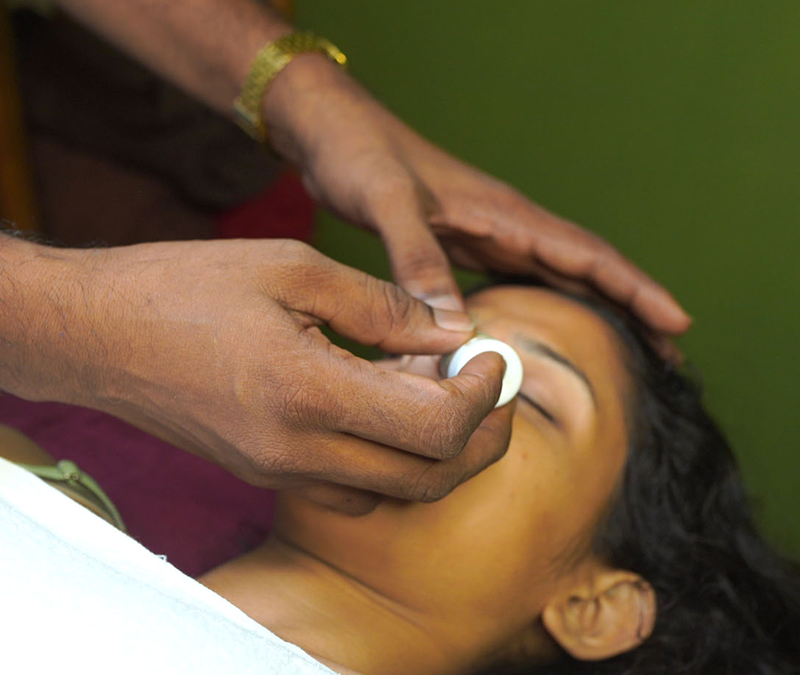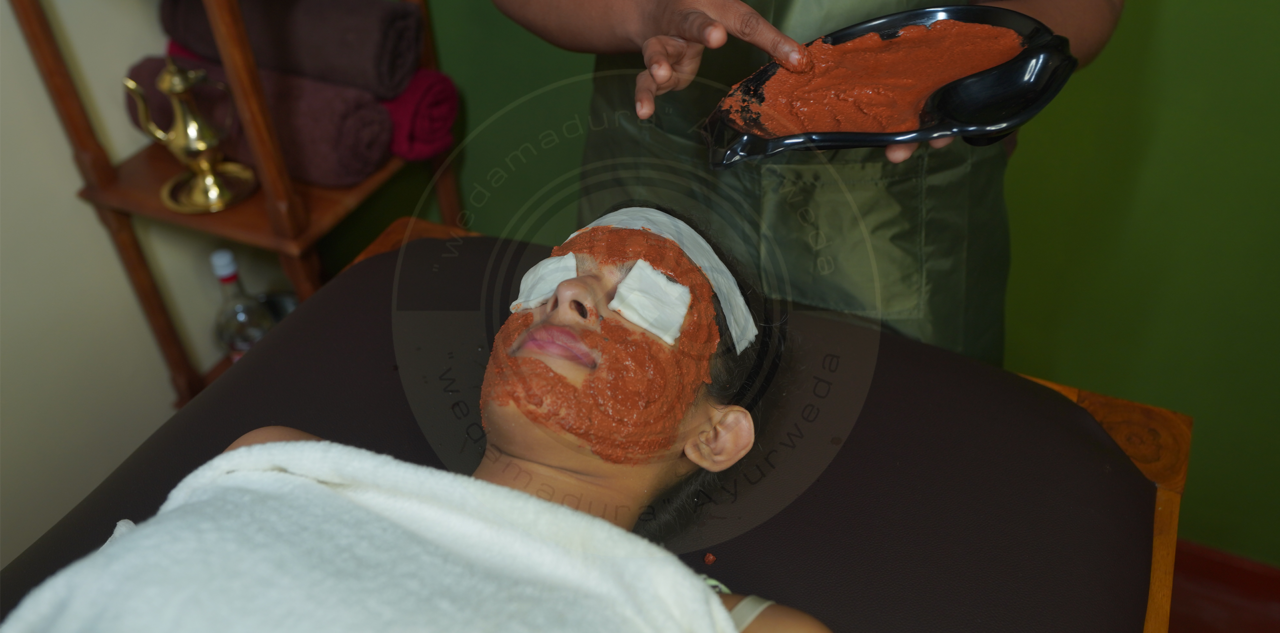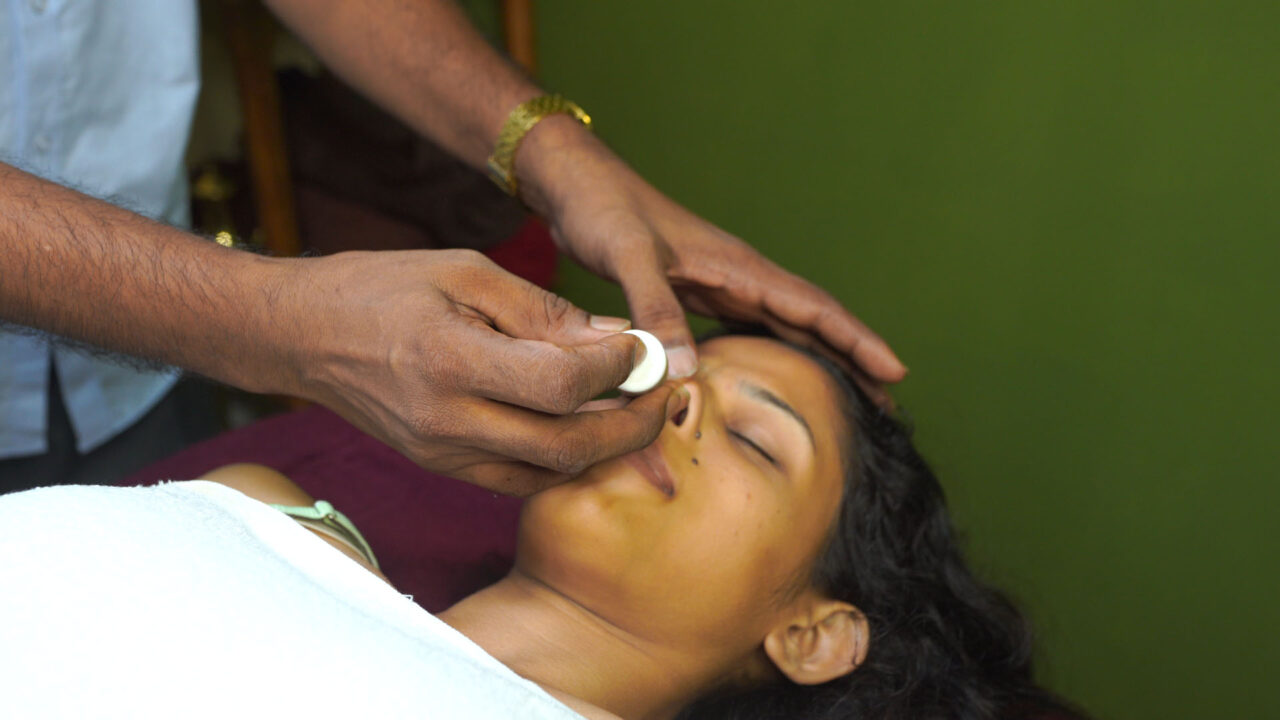- + (94) 773-674-288
- 170/A, Tiverton, Colombo Road, Peradeniya

Nasya Treatment
Introduction to Nasya
Nasya is a traditional Ayurvedic therapy that involves the administration of herbal oils, juices, or powders through the nasal passage. This treatment is designed to cleanse, purify, and strengthen the nasal passages, allowing for the optimal flow of prana (life force) vital for good health.
Historical Background
Nasya treatment is deeply rooted in ancient Ayurvedic tradition, documented extensively in classical texts like the "Charaka Samhita" and "Sushruta Samhita." These texts highlight its efficacy in treating various head-related conditions. The practice dates back thousands of years, with its origins in the Vedic period of India.
-
Enhanced respiratory health by clearing nasal passages and sinuses
-
Improved mental clarity and cognitive function
-
Relief from headaches and migraines
-
Reduction in stress and anxiety
-
Promotion of hair health and prevention of premature greying
Indications for Nasya
This treatment is particularly beneficial for conditions such as sinusitis, migraines, chronic headaches, allergies, and certain types of eye and ear problems. It can also be used to enhance mental clarity and emotional balance.
Preparation for the Treatment
Before the procedure, the patient undergoes a thorough examination to assess their overall health and specific conditions. Pre-purificatory measures (Poorvakarma) include facial oil massage or application of steam to the face, forehead, head, ears, and neck to loosen the adhesive Doshas.
The Procedure of Nasya
The treatment involves the following steps:
- Poorvakarma: Pre-purificatory measures like facial massage and steam application.
- Pradhanakarma: The main procedure involves the instillation of lukewarm medication in both
nostrils alternately using a dropper. The sole, shoulder, neck, ear, and palm are gently
massaged after the administration of the drug.
- Paschatkarma: Post-therapeutic measures include cleaning the patient's mouth with lukewarm
water and providing medicated smoke for inhalation
Post-Treatment Care
After the procedure, the patient is advised to rest and avoid exposure to cold and wind. Follow-up sessions may be recommended based on the individual's health condition. Proper post-treatment care ensures the effectiveness of the therapy and prevents any potential side effects.
Medicinal Oils Used
Various medicated oils are used in Nasya, depending on the patient's specific condition. Commonly used oils include Anu Taila, Shadbindu Taila, and Brahmi Ghrita. These oils are known for their anti-inflammatory, antibacterial, and rejuvenating properties.
Contraindications and Precautions
Nasya should be avoided in cases of acute inflammation, fever, or infections in the nasal area. It is also contraindicated for patients with certain medical conditions such as severe nasal polyps or recent nasal surgeries. Always consult a qualified Ayurvedic practitioner before undergoing this treatment.
Conclusion
Nasya is a highly effective Ayurvedic therapy for managing various head-related disorders and promoting overall well-being. Its holistic approach not only provides symptomatic relief but also enhances the health of the entire body. By integrating this traditional treatment into modern healthcare practices, individuals can experience significant improvements in their quality of life.
Rs. 2900
Duration: 60 min
Reduction in stress and anxiety
Relief from headaches and migraines
Improved mental clarity and cognitive function
Ayurvedic Tips For Healthy Children And Families
Raising a family isn't always easy, but Ayurveda offers natural solutions for health and balance. Incorporating Ayurvedic principles into your family’s routine can help strengthen immunity, promote mental well-being, and ensure holistic development.
Ayurvedic treatments offer a holistic approach to health and wellness, addressing the root causes of ailments rather than just alleviating symptoms. This ancient system of medicine, originating in India over 5,000 years ago, emphasizes the balance of mind, body, and spirit. By focusing on the individual's unique constitution, or Prakriti, Ayurveda provides personalized treatments that consider one's physical, mental, and emotional states. This personalized approach ensures that treatments are tailored to the individual's specific needs, promoting overall well-being and preventing future health issues.
One of the primary reasons to consider Ayurvedic treatments is their emphasis on natural and herbal remedies. Unlike conventional medicine, which often relies on synthetic drugs, Ayurveda uses natural herbs, oils, and minerals to restore balance and health. These natural remedies are less likely to cause side effects and are designed to work in harmony with the body's natural processes. Additionally, Ayurvedic treatments often include lifestyle and dietary recommendations, encouraging individuals to adopt healthier habits that support long-term wellness. This holistic approach not only treats existing conditions but also strengthens the body's natural defenses, making it more resilient to illness.
Furthermore, Ayurvedic treatments are known for their ability to address chronic conditions and improve overall quality of life. Many people turn to Ayurveda for relief from chronic pain, digestive issues, stress, and other long-term health problems that conventional medicine may struggle to manage effectively. Treatments such as Panchakarma (a detoxification process), Abhyanga (therapeutic massage), and Shirodhara (oil therapy) are designed to cleanse the body, reduce stress, and rejuvenate the mind and body. By incorporating Ayurvedic practices into your routine, you can experience improved energy levels, better mental clarity, and a greater sense of balance and harmony in your life.
The history of Ayurveda, one of the world's oldest holistic healing systems, dates back over 5,000 years to ancient India. The term "Ayurveda" is derived from the Sanskrit words "Ayur" (life) and "Veda" (science or knowledge), meaning "the science of life." This ancient practice is rooted in the Vedic culture, with its earliest references found in the Rig Veda, one of the oldest known texts. The foundational principles of Ayurveda were further elaborated in the classical texts of "Charaka Samhita" and "Sushruta Samhita", written around 1,000 BCE. These texts provide comprehensive insights into various aspects of health, disease, and treatment, laying the groundwork for Ayurvedic medicine.
Ayurveda's development was significantly influenced by the contributions of ancient sages and scholars. "Charaka, often referred to as the "father of Ayurveda," compiled the Charaka Samhita, which focuses on internal medicine and emphasizes the importance of balance among the body's three doshas: Vata, Pitta, and Kapha. ""Sushruta", another prominent figure, authored the Sushruta Samhita, which is renowned for its detailed descriptions of surgical techniques and procedures. This text highlights the advanced understanding of anatomy and surgery in ancient India, showcasing the sophistication of Ayurvedic practices. The integration of these texts and teachings formed a comprehensive system of medicine that addressed both preventive and curative aspects of health.
Throughout history, Ayurveda has evolved and adapted to changing times while maintaining its core principles. During the medieval period, Ayurvedic knowledge was preserved and expanded through the efforts of scholars and practitioners. The arrival of foreign influences, such as the Greeks, Persians, and later the British, introduced new medical concepts and practices, leading to a fusion of ideas. Despite these influences, Ayurveda retained its distinct identity and continued to be a vital part of Indian culture and healthcare. Today, Ayurveda is recognized globally for its holistic approach to health and wellness, offering natural and personalized treatments that promote balance and harmony in life.
Ayurveda is built on several core principles that guide its holistic approach to health and wellness. Here are the key principles:
- 1. "The Five Elements (Pancha Mahabhutas)":
Ayurveda believes that everything in the universe, including the human body, is composed of
five fundamental elements: "Earth (Prithvi), Water (Jala), Fire (Agni), Air (Vayu), and Ether
(Akasha)". These elements combine in various ways to form the three doshas, which are the
primary functional energies in the body.
- 2. "The Three Doshas (Tridosha Theory)":
The three doshas—"Vata, Pitta, and Kapha"—are the biological energies derived from the five
elements. Each dosha governs specific physiological functions:
- "Vata" (Air and Ether): Controls movement, including circulation, respiration, and nerve
impulses.
- "Pitta" (Fire and Water): Regulates metabolism, digestion, and body temperature.
- "Kapha" (Earth and Water): Maintains structure, lubrication, and stability in the body.
The balance of these doshas determines an individual's health and constitution (Prakriti).
- 3. "Prakriti and Vikriti":
"Prakriti" refers to an individual's unique constitution, which is determined at conception
and remains constant throughout life. It is the inherent balance of the three doshas.
"Vikriti", on the other hand, represents the current state of imbalance in the doshas due to
various factors like diet, lifestyle, and environment. Ayurvedic treatments aim to restore
the balance between Prakriti and Vikriti to achieve optimal health.
- 4. "Agni (Digestive Fire)":
Agni is the digestive fire responsible for the digestion, absorption, and assimilation of
food
and nutrients. Strong Agni is essential for good health, while weak or imbalanced Agni can
lead
to the accumulation of toxins (Ama) and various health issues. Ayurveda emphasizes
maintaining a
balanced Agni through proper diet and lifestyle.
- 5. "Dhatus (Tissues)":
The body is composed of seven tissues, or Dhatus: "Rasa (plasma), Rakta (blood), Mamsa
(muscle),
Meda (fat), Asthi (bone), Majja (marrow), and Shukra (reproductive tissue)". Each Dhatu has
specific functions and is nourished sequentially by the nutrients derived from food. The
health
of the Dhatus is crucial for overall well-being.
- 6. "Ojas (Vital Essence)":
Ojas is the essence of all the Dhatus and is considered the vital energy that sustains life
and
immunity. It is the ultimate product of perfect digestion and metabolism. High levels of Ojas
indicate good health, vitality, and resistance to disease, while low levels can lead to
weakness
and susceptibility to illness.
- 7. "Srotas (Channels)":
The body has numerous channels, or Srotas, through which nutrients, waste products, and
energies
flow. Proper functioning of these channels is essential for maintaining health. Blockages or
imbalances in the Srotas can lead to various diseases.
- 8. "Dinacharya (Daily Routine) and Ritucharya (Seasonal Routine)":
Ayurveda emphasizes the importance of following a daily routine (Dinacharya) and adapting to
seasonal changes (Ritucharya) to maintain balance and harmony with nature. These routines
include practices like waking up early, regular exercise, proper diet, and seasonal
detoxification.
By understanding and applying these core principles, Ayurveda aims to promote a balanced and harmonious life, preventing diseases and enhancing overall health and well-being.






